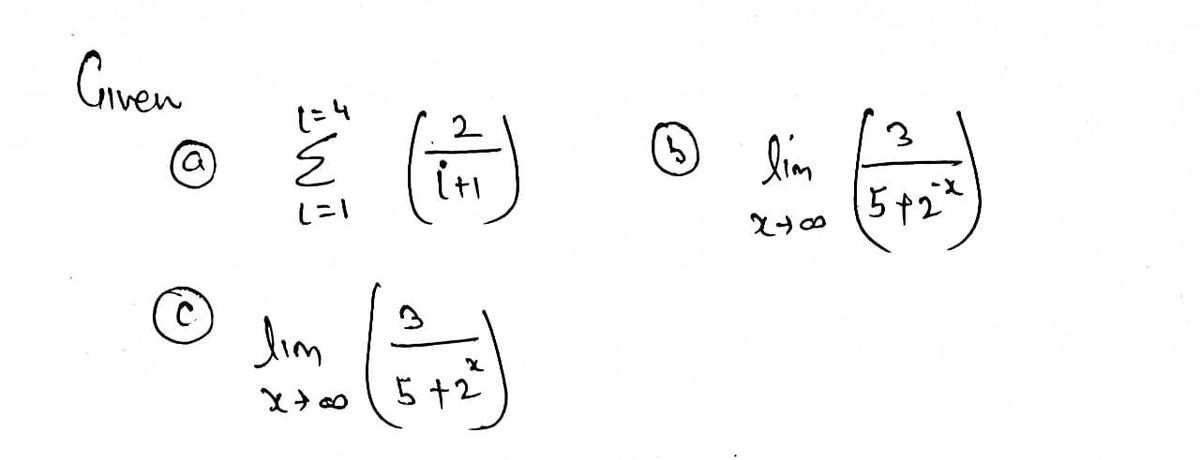Calculus: Early Transcendentals
8th Edition
ISBN:9781285741550
Author:James Stewart
Publisher:James Stewart
Chapter1: Functions And Models
Section: Chapter Questions
Problem 1RCC: (a) What is a function? What are its domain and range? (b) What is the graph of a function? (c) How...
Related questions
Question
![Certainly! Here’s a transcription and explanation suitable for an educational website:
---
### Mathematical Expressions
**a.** Evaluate the summation:
\[
\sum_{i=1}^{4} \frac{2}{i + 1}
\]
This expression represents the sum of terms where each term is calculated as \(\frac{2}{i + 1}\), with the index \(i\) ranging from 1 to 4.
**b.** Calculate the limit:
\[
\lim_{x \to \infty} \frac{3}{5 + 2^{-x}}
\]
Here, the expression asks for the limit of the fraction \(\frac{3}{5 + 2^{-x}}\) as \(x\) approaches infinity.
**c.** Determine the limit:
\[
\lim_{x \to \infty} \frac{3}{5 + 2^x}
\]
This expression seeks the limit of \(\frac{3}{5 + 2^x}\) as \(x\) goes to infinity.
### Explanation
- **Summation (\(\Sigma\))**: Summation is a concise way of adding a sequence of numbers, and it’s particularly useful when dealing with series.
- **Limit (\(\lim\))**: A limit describes the value that a function approaches as the input (or index) approaches some value. It's a fundamental concept in calculus, particularly useful in defining continuity, derivatives, and integrals.
These mathematical processes are fundamental for solving various problems in calculus and analysis, providing tools for understanding change, growth, and complex series.
---](/v2/_next/image?url=https%3A%2F%2Fcontent.bartleby.com%2Fqna-images%2Fquestion%2F1b79b02b-7faf-4a60-85a8-80947491ab86%2F4ea615e9-dc9b-4855-8d50-845062d5ed28%2Forer4pp_processed.jpeg&w=3840&q=75)
Transcribed Image Text:Certainly! Here’s a transcription and explanation suitable for an educational website:
---
### Mathematical Expressions
**a.** Evaluate the summation:
\[
\sum_{i=1}^{4} \frac{2}{i + 1}
\]
This expression represents the sum of terms where each term is calculated as \(\frac{2}{i + 1}\), with the index \(i\) ranging from 1 to 4.
**b.** Calculate the limit:
\[
\lim_{x \to \infty} \frac{3}{5 + 2^{-x}}
\]
Here, the expression asks for the limit of the fraction \(\frac{3}{5 + 2^{-x}}\) as \(x\) approaches infinity.
**c.** Determine the limit:
\[
\lim_{x \to \infty} \frac{3}{5 + 2^x}
\]
This expression seeks the limit of \(\frac{3}{5 + 2^x}\) as \(x\) goes to infinity.
### Explanation
- **Summation (\(\Sigma\))**: Summation is a concise way of adding a sequence of numbers, and it’s particularly useful when dealing with series.
- **Limit (\(\lim\))**: A limit describes the value that a function approaches as the input (or index) approaches some value. It's a fundamental concept in calculus, particularly useful in defining continuity, derivatives, and integrals.
These mathematical processes are fundamental for solving various problems in calculus and analysis, providing tools for understanding change, growth, and complex series.
---
Expert Solution
Step 1

Step by step
Solved in 2 steps with 2 images

Recommended textbooks for you

Calculus: Early Transcendentals
Calculus
ISBN:
9781285741550
Author:
James Stewart
Publisher:
Cengage Learning

Thomas' Calculus (14th Edition)
Calculus
ISBN:
9780134438986
Author:
Joel R. Hass, Christopher E. Heil, Maurice D. Weir
Publisher:
PEARSON

Calculus: Early Transcendentals (3rd Edition)
Calculus
ISBN:
9780134763644
Author:
William L. Briggs, Lyle Cochran, Bernard Gillett, Eric Schulz
Publisher:
PEARSON

Calculus: Early Transcendentals
Calculus
ISBN:
9781285741550
Author:
James Stewart
Publisher:
Cengage Learning

Thomas' Calculus (14th Edition)
Calculus
ISBN:
9780134438986
Author:
Joel R. Hass, Christopher E. Heil, Maurice D. Weir
Publisher:
PEARSON

Calculus: Early Transcendentals (3rd Edition)
Calculus
ISBN:
9780134763644
Author:
William L. Briggs, Lyle Cochran, Bernard Gillett, Eric Schulz
Publisher:
PEARSON

Calculus: Early Transcendentals
Calculus
ISBN:
9781319050740
Author:
Jon Rogawski, Colin Adams, Robert Franzosa
Publisher:
W. H. Freeman


Calculus: Early Transcendental Functions
Calculus
ISBN:
9781337552516
Author:
Ron Larson, Bruce H. Edwards
Publisher:
Cengage Learning